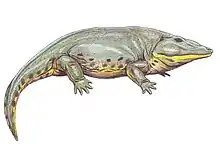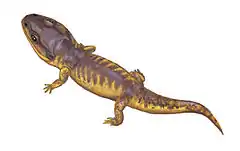Plagiosauridae
Plagiosauridae is a clade of temnospondyl amphibians of the Middle to Late Triassic. Deposits of the group are most commonly found in non-marine aquatic depositional environments from central Europe and Greenland, but other remains have been found in Russia, Scandinavia, and possibly Thailand.
| Plagiosauridae Temporal range: Early Triassic - Late Triassic | |
|---|---|
 | |
| Fossil of Gerrothorax pustuloglomeratus | |
| Scientific classification | |
| Domain: | Eukaryota |
| Kingdom: | Animalia |
| Phylum: | Chordata |
| Class: | Amphibia |
| Order: | †Temnospondyli |
| Suborder: | †Stereospondyli |
| Superfamily: | †Plagiosauroidea |
| Family: | †Plagiosauridae Abel, 1919 |
| Genera | |
Material
The majority of plagiosaurid remains are of the genus Gerrothorax, which have been recovered from the Fleming Fjord Formation of Jameson Land, East Greenland,[1] and from many localities in southern Germany.[2][3][4] All of this material is currently assigned to a single species, pulcherrimus.[1] Plagiosuchus material is also very abundant, though poorly preserved and has been found only from Germany.[5] Additional material, including the material of all other plagiosaurids, is significantly more fragmentary and less abundant than that of Gerrothorax. These additional materials are predominantly from Germany and Russia[2] with some potential material also reported from Thailand[6] and Brazil.[7]
Description
Plagiosaurids are predominantly characterized by the unique structure of their skulls and the armor that lines their trunk. The heads of these animals are short and wide with an overall semi-circular layout[1] and extremely large orbital fenestrae.[1][8] The skull and trunk of these organisms are generally vertically compressed to varying degrees within members of the clade to form an overall flattened body plan. Some articulated, three-dimensional preservation of plagiosaurids indicates that this flattening was a feature of the animals in life and is not a preservation artifact. The amount of vertical compression in plagiosaurids varies somewhat with the most basal member, Plagiosuchus, being only somewhat compressed while more derived members such as Gerrothorax and Megalopthalma being much significantly more compressed.[1][8][5] Their skull, also vertically compressed, has dorsally oriented large orbital fenestrae and contained a battery of small teeth the curve inward.[5] The trunks of these animals have shortened limbs relative their body size and the backs were generally covered in bony armor which is denser in the more derived members of the clade.[1]
Ecology
Plagiosaurids are believed to have lived an almost entirely aquatic lifestyle. Much of this interpretation stems from analysis of the remains of Gerrothorax because specimens of this group are so much more abundant and well preserved than other plagiosaurid remains.[1] Aside from their remains being found dominantly within aquatic settings, evidence for an aquatic lifestyle comes primarily from evidence that the clade possessed internal gills, given by the presence of branchial arches that were lined with arteries.[3] Additionally, the limbs of plagiosaurids are short relative to their body size and the size of their pectoral girdle. Coupled with their vertically compressed body plan, a popular interpretation for these organisms has been that they lived on the floor of freshwater systems and were obligatorily aquatic.[1][8] To facilitate a bottom dwelling lifestyle these organisms possess a special jaw joint, the atlanto-occipital joint, which facilitates the lifting of the cranium to open the mouth rather than lowering the jaw as would be expected in other organisms.[1][5] Consequently, it is presumed that the animal would lay flat on river or lake beds waiting in ambush to catch prey, such as fish.[1][8][5] It has been proposed that they may have captured prey via suction by rapidly opening their mouth and then clamping down with their curved teeth.[1][5] This is somewhat supported by the lateral elongation of the skull in later plagiosaurids like Gerrothorax and Plagiosternum compared to earlier members such as Plagiosuchus.[7] The elongation of the skull is interpreted to have facilitated muscle attachment to the back of the skull and increasing the ability and force directed toward lifting the head.
The large orbits of plagiosaurids have only been extensively analyzed in a single study which put forth two plausible eye structures.[8] According to this study, because of their incredibly flat and vertically compressed skulls, it is unlikely that the eyes actually filled the space of the groups large orbits because the eyes would permanently protrude into at least part of the palate. Thus, it is most plausible that, like many modern amphibians, the eyes of these animals were actually significantly smaller than the orbit and positioned toward the front of the skull, though there is not enough data to make conclusive judgment about their exact position. Schoch et al. (2014)[8] also put forward the hypothesis that the group had large, flat, lensless eyes similar to a family of abyss dwelling teleost fish, the Ipnopidae. These lensless eyes would allow plagiosaurids to detect when something is moving directly above them by causing a shadow in the light detected by the retina. While not observed among modern amphibians today, this hypothesis does align with the interpreted life habit of plagiosaurids and helps to explain the abnormal space afforded to the orbits of these animals.
Plagiosaurids also represent an interesting case of extreme evolutionary and morphological stasis. The features of these animals change very little through their evolutionary history despite changes. Schoch and Witzmann[9] analyzed the collections of Gerrothorax material and noted that, despite being recovered from multiple environments that encompass approximately 40 million years of time, the general body plan of Gerrothorax was relatively static. This was interpreted to support a relatively high degree of biological flexibility in these animals despite their somewhat unique ecology.
References
- Jenkins, Farish A.; Shubin, Neil H.; Gatesy, Stephen M.; Warren, Anne (2008-12-01). "Gerrothorax pulcherrimus from the Upper Triassic Fleming Fjord Formation of East Greenland and a Reassessment of Head Lifting in Temnospondyl Feeding". Journal of Vertebrate Paleontology. 28 (4): 935–950. doi:10.1671/0272-4634-28.4.935. ISSN 0272-4634. S2CID 86523094.
- Hellrung, Hanna (2003). Gerrothorax pustuloglomeratus, ein Temnospondyle (Amphibia) mit knöcherner Branchialkammer aus dem Unteren Keuper von Kupferzell (Süddeutschland): Gerrothorax pustuloglomeratus, a temnospondyle (Amphibia) with a bony branchial chamber from the Lower Keuper of Kupferzell (South Germany). Staatliches Museum für Naturkunde.
- Schoch, Rainer R.; Witzmann, Florian (2010-06-18). "Bystrow's Paradox - gills, fossils, and the fish-to-tetrapod transition". Acta Zoologica. 92 (3): 251–265. doi:10.1111/j.1463-6395.2010.00456.x. ISSN 0001-7272.
- WITZMANN, FLORIAN; SCHOCH, RAINER R.; HILGER, ANDRÉ; KARDJILOV, NIKOLAY (2011-11-25). "Braincase, palatoquadrate and ear region of the plagiosaurid Gerrothorax pulcherrimus from the Middle Triassic of Germany". Palaeontology. 55 (1): 31–50. doi:10.1111/j.1475-4983.2011.01116.x. ISSN 0031-0239.
- Damiani, Ross; Schoch, Rainer R.; Hellrung, Hanna; Werneburg, Ralf; Gastou, Stéphanie (2009-02-01). "The plagiosaurid temnospondyl Plagiosuchus pustuliferus (Amphibia: Temnospondyli) from the Middle Triassic of Germany: anatomy and functional morphology of the skull". Zoological Journal of the Linnean Society. 155 (2): 348–373. doi:10.1111/j.1096-3642.2008.00444.x. ISSN 0024-4082.
- Suteethorn, Varavudh; Janvier, Philippe; Morales, Michael (January 1988). "Evidence for a plagiosauroid amphibian in the upper triassic Huai Hin Lat formation of Thailand". Journal of Southeast Asian Earth Sciences. 2 (3–4): 185–187. doi:10.1016/0743-9547(88)90029-3. ISSN 0743-9547.
- Dias-Da-Silva, Sérgio; Milner, Andrew R. (September 2010). "The Pustulated Temnospondyl Revisited—a Plagiosternine Plagiosaurid from the Lower Triassic of Brazil". Acta Palaeontologica Polonica. 55 (3): 561–563. doi:10.4202/app.2009.0131. ISSN 0567-7920.
- Schoch, Rainer R.; Milner, Andrew R.; Witzmann, Florian (2014-02-26). "Skull morphology and phylogenetic relationships of a new Middle Triassic plagiosaurid temnospondyl from Germany, and the evolution of plagiosaurid eyes". Palaeontology. 57 (5): 1045–1058. doi:10.1111/pala.12101. ISSN 0031-0239.
- SCHOCH, RAINER R.; WITZMANN, FLORIAN (2011-10-13). "Cranial morphology of the plagiosaurid Gerrothorax pulcherrimus as an extreme example of evolutionary stasis". Lethaia. 45 (3): 371–385. doi:10.1111/j.1502-3931.2011.00290.x. ISSN 0024-1164.













